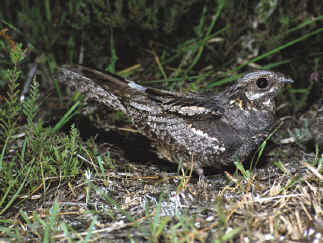Discover |
|
Devon Biodiversity Action Plan
Discover |
|
Nightjar
Caprimulgus europaeus

Image courtesy of RSPB
Nightjars
have a National Biodiversity Action Plan (BAP) devoted to them, |
| Nightjars are summer visitors to Britain, usually
arriving in April or May. They nest and raise their young here before returning to Africa
to avoid the cold winter. By October, they have all left once more. Nightjars are ground-nesting birds. This makes them very vulnerable to predators. However, they have plumage with a bark-like pattern which offers perfect camouflage. It is entirely possible to walk right past a bird sitting on its nest without seeing it, they are so wonderfully concealed. If they are startled, they open their beak into a wide gape and spread their wings and tail, to try and frighten off intruders.
The number of Nightjars breeding in Britain fell quite dramatically over the last century. This was linked to the loss of areas of heathland which is their main breeding habitat. Heathland once covered vast tracts of land in southern Britain. For varying reasons much of this heathland has disappeared. However, because the value of this habitat for all sorts of wildlife has now been recognized, concerted efforts are being made to restore and maintain areas of heathland. As a result, Nightjar numbers are slowly recovering.
Devon has the second largest population of Nightjars in South West England. It is therefore very important that their numbers should be maintained. To help achieve this, there is an Individual Species Action Plan devoted to them within the overall Devon Biodiversity Action Plan (BAP). Heathlands also have their own Habitat Action Plan within the Devon BAP. Clearly, there would not be much point in trying to promote Nightjars, without also promoting their preferred habitat. (More on Devon BAP here)
Continue to |
or
Back to